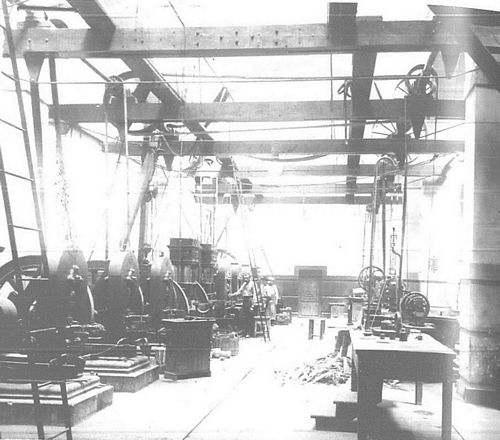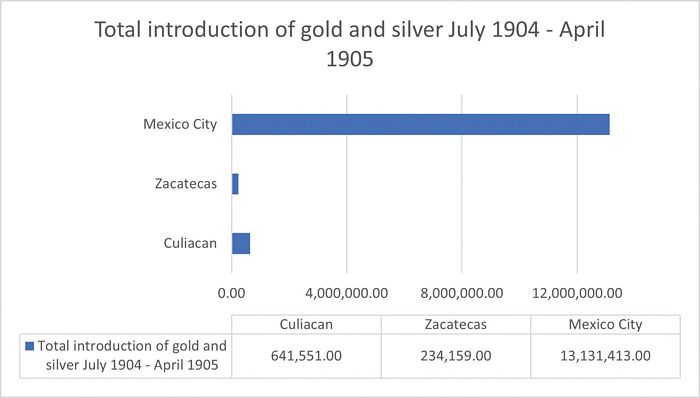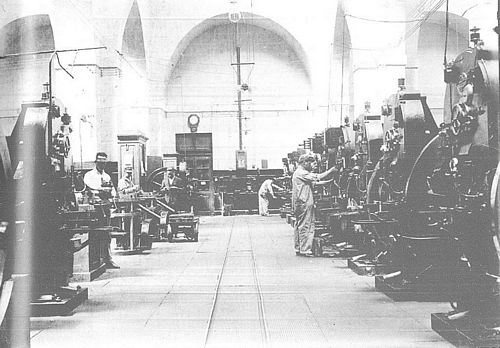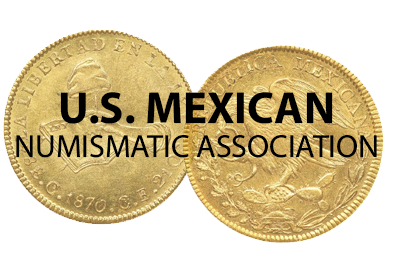The End of Provincial Mexican Mints
by Pablo Luna Herrera
Since the 16th century in the viceroyalty period different parts of the Mexican territory requested authorization to open a mintNueva Galicia (Guadalajara) 1573, Zacatecas 1575, Arizpe, Sonora 1768. For more information see: “El comienzo de las Casas de Moneda Provisionales” https://wordpress.com/page/ eldatonumismatico.wordpress.com/176. However, as it is well known, that benefit came with Independence, and thereafter, throughout all of the 19th century, more than a dozen facilities for minting coins entered into operation.
Several authors have documented this period, by explaining the leasing contracts, the relevant laws, and the minting statisticsThe classic texts are: (i) Gutiérrez, Bonifacio (1849) Memoria presentada a la Cámara de Diputados en 20 de octubre del presente año por el Secretario de Estado y Despacho de Hacienda sobre la creación y el estado actual de las Casas de Moneda de la República. [facsimile published in 1989 by the Casa de Moneda de México], (ii) Orozco y Berra, Manuel (1854) Moneda en México, in Tomo V, Diccionario Universal de Historia y Geografía. Imprenta de F. Escalante y C. [facsimile published in 1993 by the Banco de México], (iii) Pradeau, Alberto Francisco (1957) Historia Numismática de México de 1823-1950, Sociedad Numismática de México. México D.F., or more recently: (iv) Matamala, Juan Fernando (2005) Las Casas de Moneda Foráneas 1810-1905 in La acuñación en México, 1535-2005, Casa de Moneda de México. México D.F.. The purpose of this article is to highlight what were the reasons behind the closure of all the existing mints in the 1890s and the first years of the following century, focusing on the effects of the Monetary Reform of 25 March 1905. the cornerstone of the current Mexican currency system.
The government recovery of Mexican mints, from private to public interests
Since 1849 the then Secretario de Hacienda (Treasury Minister), Bonifacio Gutiérrez had manifested the harm that the leasing of regional mints was doing to the public interests:
...these contracts include privileges to produce coins, that in no way are consistent with the dignity of the Nation, the only one with the right to strike coins [...] these agreements weaken the vigilance of the mints, that in case of any mistake the liability will correspond only to the Nation... Nevertheless, taking advantage of these contracts [...] the lessees have committed several number of abusesGutiérrez, Bonifacio (1849) Memoria presentada a la Cámara de Diputados en 20 de octubre del presente año por el Secretario de Estado y Despacho de Hacienda sobre la creación y el estado actual de las Casas de Moneda de la República. [Facsimile published in 1989 by the Casa de Moneda de México].
This line of thought was debated by the Constituent representatives who wrote the liberal Constitution of 1857, but nothing was achieved; it would only take effect decades later. It was after the Second Empire, when Benito Juárez finally strengthened his power as the main political leader of the country, that this was achieved. Juárez delegated to his Treasury Ministers, Manuel Dublán and later Matías Romero, the task of arranging the matter with the private contractors.
In 1868 all the regulatory inquiries related to minting coinage were transferred from the Ministry of the Treasury to the Ministry of Development, Industry and Commerce. The reason for this change was important: the government believed that the mints would no longer be considered as a tool for making money, instead it was hoped that they would represent an industry that encouraged mining and national developmentVelasco, Omar, & Romero, Ma. Eugenia. (2020). Exportation of uncoined metals through the Mexican West Coast and the creation of the Culiacan Mint, 1825-1870. América Latina en la historia económica, 27(3), e1030. Epub 22 December 2020. https://doi.org/10.18232/alhe.1035.
On the other hand, an historical and statistical review of some of the leasing contracts shows that the government had made losses of more than one million pesos, in such cases as the Guadalupe y Calvo, Guanajuato and Zacatecas contracts. Moreover, a few lessees came to concentrate the administration of most of the mints: for example, by 1847 Manning & Mackintosh managed 80% of the national silver coin production and 90% of goldHerrera Canales, Inés (1999) El rescate de las casas de moneda: un paso a la concentración de las rentas federales a fines del siglo XIX, in El mercado de valores, Revista de Nacional Financiera, México, 11, año LIX. México D.F..
On 24 December 1871, a law was passed enacting that when the existing leases ended, all the mints would automatically pass to the control of the Federal Government. Also, revenues and tax issues related to mints, such as metal smelting, refinery and coining, would pass to government controlHerrera, op. cit..
The same political agenda was shared by Juárez’ successor, Sebastián Lerdo de Tejada (1872-1876). By the 1870s nearly all the Mexican mint had been recovered by the Federal Government, as the following chart showsI share some data with Parker J.B, Dunigan, Mike (1997) Resplandores: Cap and Rays 8 Reales of the Republic of Mexico. Superior Stamp & Coin. Beverly Hills, California.: some discrepancies may exist, confronted with sources quoted in the bibliography.:
| Mint | Government takes control |
| Durango, Durango | 1866 |
| Mexico City | 1869 |
| Culiacán, Sinaloa | 1870 |
| Alamos, Sonora | 1871 |
| Hermosillo, Sonora | 1871 |
| San Luis Potosí, San Luis Potosí | 1873 |
| Chihuahua, Chihuahua | 1874 |
| Guanajuato, Guanajuato | 1874 |
| Zacatecas, Zacatecas | 1874 |
| Guadalajara, Jalisco | 1876 |
However, all the progress achieved would temporarily be put into reverse, when Porfirio Díaz arrived in power in 1876, after the Tuxtepec revolts. The public finances of the still fragile Mexican nation faced challenges and the first option to raise money was to lease, once again, all of the mints, despite the criticisms that this was a fast alternative to obtain resourcesThroughout the entire 19th century, money was the principal reason to lease mints, the lack of revenues and a deficit in organization of the national finances by the government, as well as opposition by local businessmen and politicians. (Herrera, 1999).. The following charts the years when all the mints were leased to private contractors:
| Mint | Government cedes control |
| Durango, Durango | 1879 |
| Mexico City | 1872 |
| Culiacán, Sinaloa | 1876 |
| Alamos, Sonora | 1876 |
| Hermosillo, Sonora | 1876 |
| San Luis Potosí, San Luis Potosí | 1876 |
| Chihuahua, Chihuahua | 1880 |
| Guanajuato, Guanajuato | 1876 |
| Zacatecas, Zacatecas | 1876 |
| Guadalajara, Jalisco | 1879 |
On 12 December 1879 a new law (which rescinded the previous law of 1871) approved that the government could lease mints.
Matías Romero, in his memories, explained the main problems with the management of coining facilities in private hands:
The biggest obstacle to improve the mining industry is the harmful system of leasing mints, since this system had turned them into highly productive speculative establishments [...] that benefits only a small group...
Moreover, the historian José Manuel Sobrino has asserted that due to necessity or for the convenience of the mint lessees, the national minting provisions were not enforced. Neil S. UtbergUtberg, Neil (1963) The Coins of Mexico 1536-1963. Edinburg, Texas. explained that “…as a result of the lenient terms of the contracts and bookkeeping practices the Mexican Government lost considerable revenue and the contracting companies reaped a good harvest.”

Coining room at the Mexico City Mint in the late 1890s, all the equipment powered by steam.
(Colección CMM, MNN, Anónimo ca. quoted from Garcia Lima, 2017)
How did the Diaz government recover (this time for ever) the national mints? Several factors explain how, in a shorter period, Díaz achieved what Juárez and Lerdo de Tejada could not do.
1. Global depreciation of silver in the last quarter of the 19th century.
2. Less silver coins were exported, as opposed to bullion, and more raw silver or bars, eliminating the coining factor in the chain of productionBy 1878 87% of the exported silver were in coins, by 1900 only 19% (Herrera, 1999).
3. Industrial minerals became more attractive in the international markets.
4. Changes in revenue, tax, and mining laws.
5. New methods for coining production.
6. The consolidation of paper money.
7. The Mexican Peso decreased its use in world trade.
One might think that since the Federal Government had previously run some mints for long periods, for example Mexico City until 1847, Oaxaca from 1872 to 1893, and San Luis Potosi from 1835 to 1857, it would seem that that its intention was to keep all of them. However, the coining industry became less profitable, and coining facilities by this time only functioned to supply the domestic demand for currency (Herrera, 1999).
With a weaker coin industry, a government with better finances and more resources than before, the Díaz administration started to recover the mintsThe Banco Nacional de México helped in the process, giving loans to the government to arrange the multiple contracts (Herrera, 1999).; in 1895The decree of 15 June 1895, (that took effect on 30 June) closed all the mints and only assay offices continued to functions in Oaxaca, San Luis Potosí, Monterrey, Guadalajara, Durango, Chihuahua, Alamos and Hermosillo (Méndez Reyes, Jesús (2006) Un debate sobre la regulación económica, la Comisión de Cambios y Moneda antecedente de un banco central, in Temas a Debate. Moneda y Banca en México 1884-1954. UNAM. México D.F). The equipment and machinery of some of them were sent to the Mexico City Mint, such as the case of the San Luis Potosi mint (Sobrino, José Manuel (1989). La Moneda Mexicana, su historia. (Segunda edición). Banco de México. México D.F. )., calculating the national demand for coins and production, it decided to operate only four branches in the country: Culiacán, Zacatecas, Guanajuato and Mexico City.
The process to centralize coin production and the monetary Reform of 1905
I want to start this section with the following quote from Don and Lois Bailey that summarizes in a very clever way the monetary situation in this age:
At the beginning of the 20th century, the coinage of Mexico was in disarray. All the regional mints were in private contracts [...] Leading up to the 1905 reform, the branch mints’ contracts were beginning to come up for renewal [...] This was Mexico´s opportunity to close the branch mints and move all minting operations to Mexico City [...] The monetary reform of 1905 changed the status of the Apartado Mint from the Mexico City Mint to the Mexico Mint.
To realize why, on 31 May 1905, the Culiacán and Zacatecas mints closed (Guanajuato had already closed on 30 June 1900) it is important to understand the Monetary Act of 1905, that for decades has been the subject of debate. This is a complex topic that goes beyond this articleTo know more about this, I recommend the article: “Moneda & crisis económicas, el inicio del siglo XX en México” https:// eldatonumismatico.wordpress.com/la-crisis-de-1907-1908-y-la-estrategia-del-gobierno-con-limantour/, but its main achievement was to introduce the gold standard in MexicoThe United States introduced the gold standard in 1900, but in practice it was the regular basis since 1879.. I will here focus on the reasons for closing the coining facilities.
This was first mentioned during the London Monetary Conference of 1903, to which Mexico sent a delegation The delegation was made up of important individuals such as Manuel Fernández Leal, Director of the Mexico City Mint from 1901 to 1909, Pablo Macedo, adviser of the Banco Nacional de México (who also signed banknotes as a consejero), Joaquín D. Casasus, founder of the Banco Central Mexicano. To review the complete list, see Romero Sotelo, María Eugenia (2006) Bimetalismo vs. Patrón oro, una larga controversia en México, in Temas a Debate. Moneda y Banca en México 1884-1954. UNAM. México D.F. to learn about silver stability and depreciation, in order to plan policies regarding its domestic currency. The general consensus was that in order to achieve the stability of international exchange, it was necessary to prohibit free minting in the hands of private entrepreneurs. (the normal practice in Mexico since the Spanish period) and therefore, to close the provincial mints (Romero Sotelo, 2006).
Furthermore, Ines HerreraHerrera Canales, Inés (1999) Casa de Moneda de México en el siglo XIX: de la pérdida a la recuperación del monopolio de acuñación en Casa de Moneda de México, Cinco Siglos de Tradición. Secretaría de Hacienda y Crédito Público. México D.F. add that the advances achieved in metallurgy at that time converted Mexico into an attractive country not only in precious metals, but also in industrial metals. Foreign capital and investors stopped seeing mints as the only lucrative business, migrating to other types of industrial refining factories.
In this same topic, since the Monetary Act of 25 March 1905 focused on gold issues (the international standard) lawmakers believed that Mexico should start to produce more gold pieces than silver ones, whereas the provincial mints were producing mainly silver and copper piecesBetween 1905 to 1910 gold production went from 89 to 164 tons (Méndez, Reyes 2006).. In the Memoria of 1905Memoria de Hacienda y Crédito Público, correspondiente al año económico de 1 de Julio de 1904 a 30 de Junio de 1905, presentada por el Secretario de Hacienda al Congreso de la Unión. Tipografía de la Oficina Impresora de Estampillas. Palacio Nacional, México D.F. that is proved in the following way:

Also, since 1902 new machinery and equipment was purchased for the Mexico City mint to improve the supply of the nation with new coins. In this regard Salvador García Lima (2017) added the followingTo know more about the main changes in the Mexico City Mint in the first years of the 20th century see García Lima, Salvador (2017) El Ingeniero Francisco Valdés y la planta de Apartado. Casa de Moneda de México. Ciudad de México.:
...the adoption of electrical energy as a source of lighting and motor force, with the recovery of the coinage monopoly [...] and the Monetary Reform of 1905, which forced the managers to adopt urgent measures to provide efficient machinery capable of facing the technical challenge implied by the minting of a complete monetary family nationwide...
Years later the Mexico Mint would request foreign mints in the United Kingdom and the United States to complement its own production with foreign mintingTo know more about Mexican coins produced in foreign countries I recommend (i) Long, Richard (1976) The Availability of 20th Century Mexican Coins. Wegferd Publications. Bandon, Oregón and (ii) Bailey, D., & Bailey, L. (2015) Whitman Encyclopedia of Mexican Money, Volume 2, Modern Coins of Mexico, 1905 to Date. Whitman Publishing. Atlanta, Georgia., but this is a topic for another time.
Conclusions
As discussed, the main debate on recovering all the mints was the idea that the administration of the mints by private lessees was unscrupulous. The necessities of war obliged the government to issue leases again, and only international trade made it easier for the federal administration to achieve control of all the mints. I believe that from the experience acquired throughout the 19th century the solution was to centralize all the operations. From 1895 the Mexico City Mint became the only factory to produce coins and the provincial mints took on other functions. This system was intended to create standardized proceedings and uniform coins. The government institution that managed the monetary procedures was the Exchange and Currency Commission (Comisión de Cambios y Moneda) created on 3 April 1905García Lima, Salvador (2017) El Ingeniero Francisco Valdés y la planta de Apartado. Casa de Moneda de México. Ciudad de México..

Coining room at the Mexico City Mint in the 1930s, all the equipment powered by electricity.
(Colección CMM, MNN, Anónimo ca. quoted from Garcia Lima, 2017)
This was a change that was completed in other areas of the economy such as the railroads, lighting companies, and oil companies. Sooner or later the government decided to control (monopolize) all these industries (although for different reasons) considering not only their profitability but them as industries at the service of society.
I appreciate the help and advice of Alma Parra Campos PhD.
